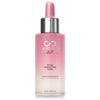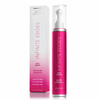
What is the Average Age People Start Losing Hair?

Are there bald spots on your head? Or are you finding more hair on your comb or in your shower drain? Don't fret! As frustrating as hair loss might be to deal with, it's often recoverable in the majority of cases. First of all, you need to know what's causing your symptoms.
Hair loss may be caused by genetics, underlying medical issues, or stress. You may not be aware, but your age could also be a contributing factor to hair loss. The reasons for hair loss in teens are different from those of older people.
As we become older, both men and women notice a decrease in hair volume and thickness. Androgenic alopecia, which is more frequent in males, may begin at any age, and the rate at which it worsens could be determined by genes.
If you've been wondering at what age hair starts to fall, then you're at the right place. For both men and women, hair loss may occur at any age, and this article will explain why.

What Is The Average Age Men Start Losing Hair?
Hair loss may begin at any age, as previously said.
Androgenic alopecia (a kind of male pattern baldness) may strike men of any age. Hair loss, on the other hand, seems to increase with age. Men begin to lose their hair at a younger age than women.
HAIR THINNING IN ADOLESCENCE
Isn't that interesting? In adolescence, hair loss is common. As early as 16 to 17 years old, hair loss may occur. Teenagers seldom lose their hair, but when they do, it's usually in the form of mild hair thinning and a receding hairline.
Teenagers who are dealing with hair loss sometimes feel overwhelmed and traumatized. However, it's not anything to be concerned about since it's just transitory.
Several factors contribute to hair loss in adolescents, such as an underlying medical condition, trichotillomania, alopecia areata, poor nutrition, and the use of harsh hair products and styling instruments.
For the greatest results, find out what's causing your hair loss and look for a treatment option that works best for you. Before beginning any therapy, you should, of course, speak with your physician.
HAIR LOSS IN YOUR TWENTIES
Male pattern baldness is a prevalent cause of hair loss in males in their twenties.
About 20% of men begin to lose their hair by the time they are 20 years old, according to recent studies.
You're meeting new people and forming relationships at this stage, so losing your hair might impair your self-esteem and cause you to feel self-conscious. Consider trimming your hair completely to safeguard your mental health if you find it appealing.
Hair loss in males in their 20s may be caused by telogen effluvium, poor skin, vitamin deficiencies, hormones, smoking, and dandruff.
It's better to find out what's causing your hair loss and begin treatment sooner rather than later.
HAIR LOSS IN THE THIRTIES AND UPWARDS
Men are more likely to become bald by the time they're 30 than women, according to a number of studies. A good number of men develop hair loss or have bald spots by the time they reach their 50s or 60s.
Men's hair loss is increasingly prevalent with age, but it doesn't mean they should just accept it. You still have hope of regaining your hair if you get treatment.
There are many of the same reasons for hair loss in the 20s and 30s. However, at the age of 50, heredity, hormones, androgenic alopecia, and old age are the primary causes of male pattern baldness.
Talk to your doctor about the best treatment options for your specific situation.
MEN'S HAIR LOSS PREVENTION AND TREATMENT
The best strategy to deal with hair loss is to prevent it. It's possible to decrease the progression of hair loss even though certain factors are beyond your control.
Hair loss may be prevented or slowed down by following these tips:
- Maintaining a healthy and balanced diet. Try adding a multivitamin designed to stop hair loss and promote regrowth, like HAIRFINITY DHT Blocker.
- Avoiding the use of harsh hair products and heated styling tools
- Switching to medications that don't have hair loss side effects
- Using combs with more open areas and natural fiber brushes
- Avoid tugging your hair excessively.
- Don't use harsh shampoos. Try using sulfate free shampoos, like HAIRFINITY Gentle Cleanse Shampoo or HAIRFINITY Biotin Shampoo.
It's important to know, though, that certain forms of hair loss are unavoidable. Simple and effective therapeutic approaches exist to combat hair loss. These are a few examples:
- OTC Medications
There are a number of over-the-counter drugs that may be used to treat hair loss. Tablets, ointments, and foams are all available.
Minoxidil and Finasteride are the two most often prescribed hair growth treatments.
After discovering that excessive hair growth is a side effect of using Minoxidil, the firm decided to reevaluate its usage in treating male pattern baldness rather than only hair loss.
Taking the medicine widens the follicles of hair, resulting in thicker strands of hair. Additionally, it extends the growth phase of hair, resulting in longer and fuller hair strands.
If you are over 40, the FDA-approved drug is more successful in treating various forms of hair loss.
Instead of treating prostate cancer, finasteride works by reducing DHT levels in the body. Finasteride is an effective treatment for hair thinning, male pattern baldness, and other hair issues since it has been shown that an increase in DHT in the scalp causes hair loss.
The medication does not affect hair development elsewhere on the body, however it is only for use by adults and should not be used by women who are pregnant.
After three months of using the drug in either the topical or oral version, some people experienced a change in their skin.
Both Finasteride and Minoxidil might have adverse effects, so talk to your doctor before starting either one.
- A Balanced Diet
Deficiencies in some nutrients might lead to hair loss. Adding some fruits, nuts, and fatty fish to your diet can help promote healthy hair growth and reduce hair thinning.
For those who suffer from hair loss that is caused by an imbalance of nutrients in their diets, eating a well-balanced diet may assist in reversing hair loss.
- Hair Transplant
A hair transplant is a suitable therapeutic option if your baldness is severe and has spread to the majority of your head.
Hair follicles from the back of the head (which is resistant to DHT) are removed and transplanted to the balding area of the scalp in this procedure.
Hair transplants, like any other kind of surgery, may go wrong. Excessive bleeding and large scarring are possible side effects.
What Is The Typical Age At Which Women Begin To Experience Hair Loss?
Women's hair loss is particularly aggravating, given how much they rely on their hair to enhance their appearance. In most cases, it hurts women's social lives and self-confidence.
Hair loss in women, as it does in males, may occur at any age and for a variety of reasons. Let's have a look at the rate of hair loss among women of various ages.
HAIR LOSS IN THE TWENTIES AND THIRTIES
Only a small percentage of women begin to notice hair loss at the age of 20. Hair loss in this age range is often caused by a number of causes that may be addressed to halt the process.
Experiencing hair loss in one's early twenties and thirties may be a frightening and stressful experience.
When people reach this age, the most prevalent causes of hair loss are stress from dieting and changes in hormone levels.
The telogen phase of hair follicles, which finally leads to shedding, is accelerated by chronic stress. If you've been under a lot of stress for three months, you could notice that your comb and shower are becoming clogged with hair.
Crash diets may cause hair loss, so to prevent this, go for moderate and steady weight reduction approaches, while making sure you're getting enough nutrition.
Giving birth or stopping a medication may cause hair loss as well. You may notice hair loss and thinning as your body adapts to hormonal changes.
If you're in your 20s or 30s and you're losing your hair, do some research to find out what's causing it and how to fix it, or see your doctor.
HAIR LOSS IN THE FORTIES AND FIFTIES
Women, like men, are more susceptible to hair loss as they become older.
Genetics is the most common factor contributing to hair thinning and balding in older adults. In addition to hair loss, menopause results in a significant decline in estrogen levels.
Inflammation caused by menopause may harm hair follicles, resulting in a receding hairline. Menopause exacerbates hair loss in those who already have a hereditary predisposition to it.
Harsh hairstyles in the twenties and thirties is another prevalent cause of hair loss in women in their forties. Relaxers and other hot tools, braids, and tight ponytails inflame our hair follicles and put tremendous strain on them. Balding, thinning, and hair loss are all possible outcomes of this injury to the hair follicles.
If detected early enough, hair loss in the 40s and 50s may be somewhat managed. Before beginning any treatment, get the opinion of a hair professional or your doctor.
HAIR LOSS IN THE 60S AND ABOVE
It's not only your skin and bones that age, but your hair as well. Getting older and some drugs might have an impact on your hair, especially beyond the age of 60.
Hair thinning, graying, and thinning strands are all signs of aging hair. Because of this, the growth and fallout of your hair is going to be altered.
Older people are more likely to suffer from underlying health problems such as anemia, hypothyroidism, and nutritional inadequacies, which may cause hair loss. Hair loss is a typical side effect of cancer treatment and chemotherapy.
If you have underlying health issues, you may notice thinning hair, but you won't see any bald spots. Hair loss may be reduced with treatment.
Hair loss may also occur as a side effect of drugs in old age. Medications for high cholesterol, high blood pressure, and certain arrhythmias have all been linked to hair loss in the past.
Consult your physician about additional treatment choices.
Women's Hair Loss: Preventative Measures and Treatment
Hair loss may be lessened by either doing or not doing certain things. The following are some of the most important actions you can take:
- During your twenties, steer clear of harsh hair products and hot styling equipment.
- Avoid wearing your hair in tight buns or braids, which put pressure on the follicles and cause damage.
- Avoid quick weight loss methods
- Make the switch to hair-safe drugs.
- OTC Medications:
Men and women may both benefit from a wide range of over-the-counter drugs aimed at slowing or stopping hair thinning.
Minoxidil, an FDA-approved medicine for hair loss and growth, is the most common.
Ketoconazole, a medication used to treat hair loss caused by inflammation of the hair follicles, is also an option.
Using the medicine in a topical form may help decrease inflammation and decelerate hair loss, according to doctors. Shampoos and topicals with low or high doses of ketoconazole may be found both online and in stores, as well.
- Hormonal Therapies:
If your doctor determines that your hair loss is the result of a hormonal imbalance, he or she may recommend one or more hormone therapy.
There are a variety of options, including birth control pills and hormone replacement therapy, for treating an unbalanced hormone.
Preventing hair loss is another purpose for antiandrogens, as well. However, there may be side effects from these drugs, so it's a good idea to discuss them with your doctor beforehand.
- Use Hair Thickening Shampoo:
Some hair products and hard water may produce clogged hair follicles, which can lead to hair loss. De-clogging hair follicles using a volumizing or thickening shampoo may help build a long, thick hairstyle. Try HAIRFINITY Grow Stimulating Shampoo, which is Infused with caffeine, peppermint, and biotin. This invigorating formula removes excess oils without stripping hair and provides a soothed scalp, fresh tresses, and follicles that can finally breathe.
Takeaway
Men and women both begin to lose their hair on average in their twenties. Hair loss at this age is very rare, but it is treatable if detected early enough.
The reasons for hair loss may vary from early on in one's life to later in one's life, and some are reversible while others are not. As long as the hair loss isn't irreversible, the good news is that practically all phases of hair loss can be reversed.
Consult a specialist or try some natural hair loss remedies.































